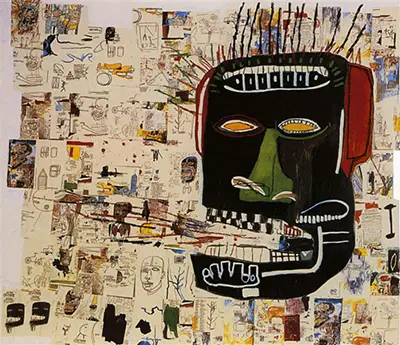It is an exciting and very large piece which remains today in a private collection, where it has been ever since that high profile purchase. The artwork was sold via Christie's and their entry on the sale lists it as having been produced using acrylic, oilstick and xerox collage. It is confidently dated at 1985, with the artist having also written the same year on the back of the stretching frame. It is over two and a half metres wide, and around three metres in height making it a very large piece, though that was not uncommon for this artist during this point in his career. The artist wrote the title on the back, alongside his own signature.
The main focus here is the huge head which dominates the right hand side of the painting. This was the artist's way of expressing his own inner turmoil, and he used this symbol across many other paintings. We find red lines violently appearing from his mouth, matching the frenetic hair and marks around his forehead. This was art meeting therapy in a way, as Basquiat attempted to rid himself of his demons by placing them on paper or canvas, or at the very least creating visual forms of them for his own work. This was inspiration and turmoil together in a single package, just as we famously saw within the career of Dutch artist Vincent van Gogh. Beyond this expressive nature, what else is included within this painting? There are countless numbers of xerox printed pages across the background which clearly serve more than just an aesthetic purpose.
Basquiat would feature the human body within many of his artworks, but rarely would the whole body be included. He could use different parts to symbolise all manner of different things, such is the varied scope of our physical makeup. The head is clearly the most important and can be used in itself to mean different things, which is why it appear so often. There would be patterns of eyes in other places, and even some dog limbs too. In some cases he felt the need to include labels alongside such items because of the obscurity of some of his choices, although even written texts was not always enough to make us any the wiser.


